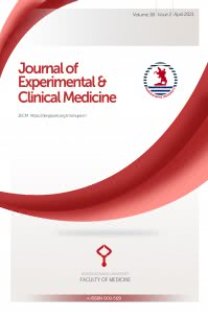Erişkin yaş grubu intraventriküler kanamaları ve sonuçları
Geriyedönük çalışma, Erişkin, Subaraknoid kanama, Ventrikül basıncı, Ölüm oranı, Drenaj, Beyin omurilik sıvısı
Intraventricular hemorrhage and results in adults
Retrospective Studies, Adult, Subarachnoid Hemorrhage, Ventricular Pressure, Mortality, Drainage, Cerebrospinal Fluid,
___
1. Findlay JM. İntraventricular hemorrhage. Neurosurgery Quarterly 10: 182-195, 2000. 2. Hashimoto T, Nakamura N, Ke R, et al. Traumatic intraventricular hemorrhage in severe head injury. No Shinkei Geka 1992; 20: 209-215. 3. Hayashi M, Handa Y, Kobayashi H, et al. Prognosis of intraventricular hemorrhage due to rupture of intracranial aneurysm. ZentraJbl Neurochir 1989: 50: 132-137. 4. Liliang PC, Liang CL, Lu CH, et al. Hypertensive caudate hemorrhage prognostic predictor, outcome, and role of external ventricular drainage. Stroke 2001; 32: 1195-1200. 5. Maeda K, Kurita H, Nakamura T, et al. Occurrence of severe vasospasm following intraventricular hemorrhage from an arteriovenous malformation. Report of two cases. J Neurosurg. 1998; 88: 934-935. 6. Naff NJ, Tuhrim S. Intraventricular hemorrhage in adults: complications and treatment. New Horiz 1997; 5: 359-363. 7. Naff NJ. Intraventricular Hemorrhage in Adults. Curr Treat Options Neurol 1999; 1: 173-178 8. Nagaratnam N, Saravanja D, Chi4 K, et al. Putaminal hemorrhage and outcome. Neurorehabil Neural Repair 2001; 15: 51-56. 9. Pasqualin A, Bazzan A, Cavazzani P, et al. Intracranial' hematomas following aneurysmal rupture: experience with 309 cases. Surg Neurol 1986; 25: 6-17. 10. Wang YC, Lee SD, Chen NF, et al. Cerebral intraventricular hemorrhage caused by a large cerebral arteriovenous malformation at 31 years after diagnosis. Zhonghua Yi Xue Za Zhi (Taipei) 2001; 64: 121-128. 11. Yanaka K, Hyodo A, Tsuchida Y, et al. Symptomatic cerebral vasospasm after intraventricular hemorrhage from ruptured arteriovenous malformation. Surg Neurol 1992; 38: 63-67. 12. Claassen J, Bernardini GL, Kreiter K, et al. Effect of cisternal and ventricular blood on risk of delayed I cerebral ischemia after subarachnoid hemorrhage: 1 the fisher scale revisited. Stroke 2001; 32: { 2012-2020. age. ! 13. Yaşargil MG. Microneurosurgery: Microsurgical ' anatomy of the basal cisterns and vessels of the latic _____ brain, diagnostic studies, general operative techniques ury. and pathological consideration of the intracranial aneurysm. Georg Thime Verlag Stuttgart. New York. IOSIS 1984; s 279-349. e of 14. Findlay JM, Grace MG, Weir BK. Treatment of 989: intraventricular hemorrhage with tissue plasminogen activator. Neurosurgery 1993; 32: nsive 941-947. ome, 15. Horvath Z, Veto F, Balas I, et al. Biportal endoscopic ge. removal of a primary intraventricular hematoma: case report. Minim Invasive Neurosurg 2000; 43: 4-8. rence 16. Naff NJ, Carhuapoma JR, Williams MA, et al. Lcular Treatment of intraventricular hemorrhage with ation. urokinase: effects on 30-Day survival.Stroke 2000; ; 88: 31: 841-847. 17. Nieuwkamp DJ, de Gans K, "Mnkel GJ, et al. age in Treatment and outcome of severe intraventricular Horiz extension in patients with subarachnoid or intracerebral hemorrhage: a systematic review of the adults. literature. J Neurol 2000; 247: 117-121. 18. Onoda K, Kurozumi K, Tsuchimoto S, et al. et al. Experience with the high occipital transcortical rehabil approach in the treatment of intraventricular hemorrhage. Report of two cases. J Neurosurg et al. 2001; 94: 315-317. rysmal 19. Weninger M, Salzer HR, Pollak A, et al. External Neurol ventricular drainage for treatment of rapidly progressive posthemorrhagic hydrocephalus. lerebral Neurosurgery 1992; 31: 52-57. 20. Tuhrim S, Horowitz DR, Sacher M, et al. Volume of ventricular blood is an important determinant of outcome in supratentonal intracerebral hemorrhage. Crit Care Med. 1999; 27: 477-478. 21. Bilinska M, Swierkocka-Miastkowska M, et al. Primary and secondary intraventricular hemorrhage clinical analysis. Neurol Neurochir Pol 1999; 32 (Suppl 6): 141-147. 22. Debois V. Intraventricular hemorrhage: Relation between the symptomatology and computed tomography. Neurochirurgie 1979; 25: 71-7£. 23. Bakshi R, Kamran S, Kinkel PR, et al. MRI in cerebral intraventricular hemorrhage: analysis of 50 consecutive cases. Neuroradiology 1999; 41: 401-409. 24. Bernad PG, Taft PD. Cytologic diagnosis of intraventricular hemorrhage in a neonate. Acta Cytol 1980; 24: 4-6. 25. Craver RD. The cytology of cerebrospinal fluid associated with neonatal intraventricular hemorrhage. Pediatr Pathol Lab Med 1996; 16: 713-719.26. Fukumizu M, Takashima S, Becker LE. Neonatal posthemorrhagic hydrocephalus: neuropathologic and immunohistochemical studies. Pediatr Neurol 1995; 13: 230-234. 27. Fukumizu M, Takashima S, Becker LE. Glial reaction in periventricular areas of the brainstem in fetal and neonatal posthemorrhagic hydrocephalus and congenital hydrocephalus. Brain Dev 1996; 18: 40-45. 28. Paul DA, Leef KH, Stefano JL. Increased leukocytes in infants with intraventricular hemorrhage.Pediatr Neurol 2000; 22: 194-209. 29. Wei W, Xin-Ya S, Cai-Dong. L, et al. Relationship between extracellular matrix both in'choroid plexus and the wall of lateral ventricles and intraventricular hemorrhage in preterm neonates. Clin Anat 2000; 13: 422-428. 30. Mohr G, Ferguson G, Khan M, et al. Intraventricular haemorrhage from ruptured aneurysm. J Neurosurg 1983; 58: 482-487.
- ISSN: 1300-2996
- Yayın Aralığı: Yılda 4 Sayı
- Başlangıç: 2018
Bilateral diz eklemi yerleşimli lipoma arboresens olgusu
Mustafa Bekir SELÇUK, Alper Kubilay YAZICIOĞLU, Çetin ÇELENK, Mehmet Selim NURAL, Hüseyin AKAN
Primary cerebellar agenesis-chiari IV malformation
Deniz TEKİN, Serap UYSAL, Ömer İYİGÜN
Kronik B hepatitli çocuklarda interferon tedavisinin hematolojik yan etkileri
Yılmaz KANBER, Ayhan Gazi KALAYCI, Hasan YILDIRIM, AYHAN DAĞDEMİR, Davut ALBAYRAK
EDİBE PİRİNÇCİ, Ferdane OĞUZÖNCÜL, Yasemin AÇIK
Nitrik oksitin Mycobacterium tuberculosis'e etkinliğinin in vitro araştırılması
AHMET YILMAZ ÇOBAN, Belma DURUPINAR
Rokuronyum enjeksiyon ağrısının önlenmesinde ondansetron ve lidokainin karşılaştırılması
Ebru KELSAKA, Sibel BARIŞ, Hale KEFELİ, Asuman MEHEL, Deniz KARAKAYA, Serhat KOCAMANOĞLU, Ayla TÜR
Erişkin yaş grubu intraventriküler kanamaları ve sonuçları
Cengiz ÇOKLUK, Alpaslan ŞENEL, Keramettin AYDIN, Cihangir GÜNDÜZ, Ömer İYİGÜN, ARİF ÖNDER, Cemil RAKUNT, Fahrettin ÇELİK
Hayati AKBAŞ, Ahmet DEMİR, Ethem GÜNEREN, Lütfi EROĞLU, İbrahim ORAK, Levent YILDIZ
Koledok taşlarının tanısında manyetik rezonans kolanjiografi ve ultrasonografi
Murat DANACI, AHMET VEYSEL POLAT, Ayfer KAMALI, Ümit BELET, Lütfi İNCESU, Necati ÖZEN, Mustafa Bekir SELÇUK
